Oldenburg Time Drifts Oldenburg 2023 Philipp Geist from Philipp Geist | Videogeist on Vimeo.
<

Lichtkunst Installation 'Time Drifts Oldenburg' im Rahmen des hundertjährigen Jubiläums des Landesmuseums in Oldenburg 2023
Anlässlich des 100jährigen Jubiläums entwickelt der Berliner Künstler Philipp Geist eine poetisch-malerische Licht-Video-Installation auf der Fassade des Landesmuseums in Oldenburg. Es entsteht ein künstlerisches Zusammenspiel zwischen der historischen Fassade und den audio-visuellen Inhalten der Mapping-Projektion. Geplant ist ein immersiver Lichtraum, eine begehbare Lichtinstallation, die die Besucher einlädt, in die Lichtwelten des Künstlers einzutauchen. Die Besucher, die sich vor dem Landesmuseum, dem Oldenburger Schloss, aufhalten, werden zu einem Teil der Projektion. Auf den Boden und die Besuchern werden die Begriffe, Wörter und Assoziationen rund um die Themen des Landesmuseums Oldenburg projiziert. Hierfür wird auf den Boden des Schlossplatzes projiziert. Seit 100 Jahren befindet sich das Landesmuseum in dem historischen Schloss. Viele geschichtliche Ereignisse sind an diesem Zeitzeugnis der Oldenburger Geschichte vorbeigegangen. Das Einbeziehen von historischen Momenten in die malerischen Bildkompositionen, die Integration von Porträts von Persönlichkeiten, Jahreszahlen und historischen Begriffen schafft eine geschichtliche Verbindung. Der Ort wird in einen sich verändernden Raum aus Licht und Begegnung verwandelt. Das Fassadenmapping, welches die Elemente aus der historischen Architektur nachzeichnet, verstärkt die Architektur und versetzt sie aus dem Gleichgewicht in Bewegung. Das Museum steht für das Bewahren der Geschichte und der Kultur der Stadt, sowie die Vermittlung und Kommunikation des Vergangenen. Die künstlerische Installation verbindet die Geschichte mit der Jetzt-Zeit und den modernen Möglichkeiten, einen künstlerischen Erlebnisraum zu kreieren. Die projizierten Begriffe und Gedankenfragmente beschäftigen sich mit Vielschichtigkeit und Vielsichtigkeiten, mit den Geschichten und Gesichtern der Stadt. Dabei ist die Teilnahme der Bevölkerung ganz wesentlich. Es wurde ein Wort- und Begriffaufruf an die Oldenburger Bevölkerung im Vorfeld der Installation gemacht. des Weiteren wurden aktuelle Porträts von Oldenburger Bürgern angefertigt, die in die Installation integriert werden. Musikalisch wird die Installation durch eine Musik- Komposition von Lukas Taido mit dem Sprecher Mathias Kopetzki. Bei der Installation geht es um eine assoziative Interpretation der Oldenburger Geschichte, mit den Exponaten der Sammlung und der Integration von aktuellen Begriffen und Porträts. die in die abstrakt-malerischen Bildkompositionen und die visualisierten Elemente, die teils schemenhaft, teils figurativ sind, integriert werden. Geists Projekte sind in erster Linie gekennzeichnet durch ihre Komplexität in der Integration von Raum, Ton und Bewegtbild. Seine Video-Mapping-Installationen verwandeln verschiedenste Architekturen und Orte weltweit in bewegte, malerische Lichtskulpturen, die die Wahrnehmung der Betrachter von Zwei- und Dreidimensionalität herausfordern.
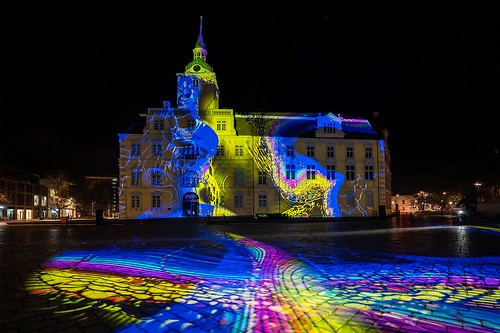
Light art installation 'Time Drifts Oldenburg' as part of the centenary of the Landesmuseum in Oldenburg 2023
On the occasion of the 100th anniversary, the Berlin artist Philipp Geist developed a poetic-painterly light-video installation on the facade of the State Museum in Oldenburg. An artistic interaction is created between the historic facade and the audio-visual content of the mapping projection. An immersive light room is planned, a walk-in light installation that invites visitors to immerse themselves in the artist's world of light. The visitors who are in front of the State Museum, the Oldenburg Castle, become part of the projection. Terms, words and associations related to the themes of the Oldenburg State Museum are projected onto the floor and onto the visitors. For this purpose, a projection is made onto the floor of the Schlossplatz. The State Museum has been located in the historic castle for 100 years. Many historical events have passed this testimony of Oldenburg's history. The inclusion of historical moments in the pictorial compositions, the integration of portraits of personalities, dates and historical terms creates a historical connection. The place is transformed into a changing space of light and encounter. The facade mapping, which traces the elements from the historical architecture, reinforces the architecture and sets it in motion out of balance. The museum stands for preserving the history and culture of the city, as well as conveying and communicating the past. The artistic installation connects history with the present and the modern possibilities to create an artistic space of experience. The projected terms and thought fragments deal with complexity and multiple perspectives, with the stories and faces of the city. Public participation is very important. Words and terms were called out to the population of Oldenburg prior to the installation. Furthermore, current portraits of Oldenburg citizens were made, which are integrated into the installation. The installation is musically composed by a music composition by Lukas Taido with the narrator Mathias Kopetzki. The installation is about an associative interpretation of Oldenburg's history, with the exhibits of the collection and the integration of current terms and portraits. which are integrated into the abstract-painterly picture compositions and the visualized elements, which are partly shadowy, partly figurative. Geist's projects are primarily characterized by their complexity in the integration of space, sound and moving images. His video mapping installations transform a wide variety of architecture and locations worldwide into moving, picturesque light sculptures that challenge the viewer's perception of two and three dimensions.
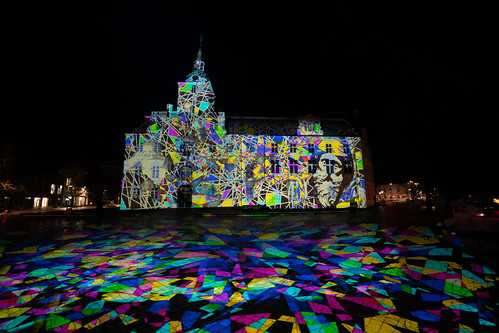
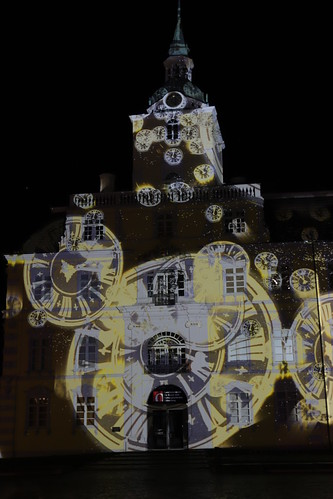
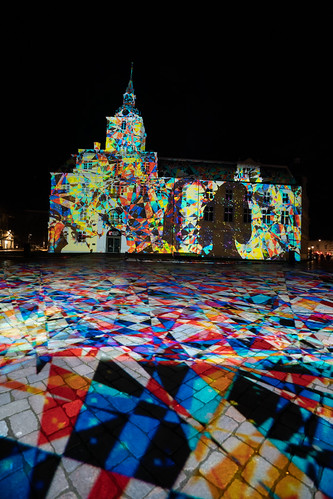
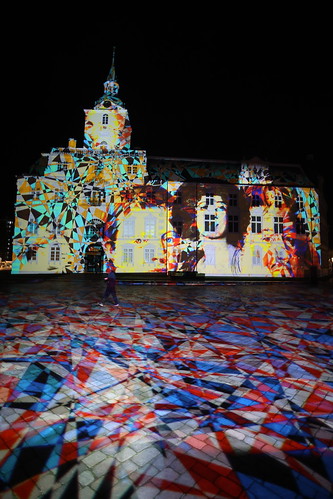
Photos by Holger Menzel & Philipp Geist
MOVIE ONLINE
<
<